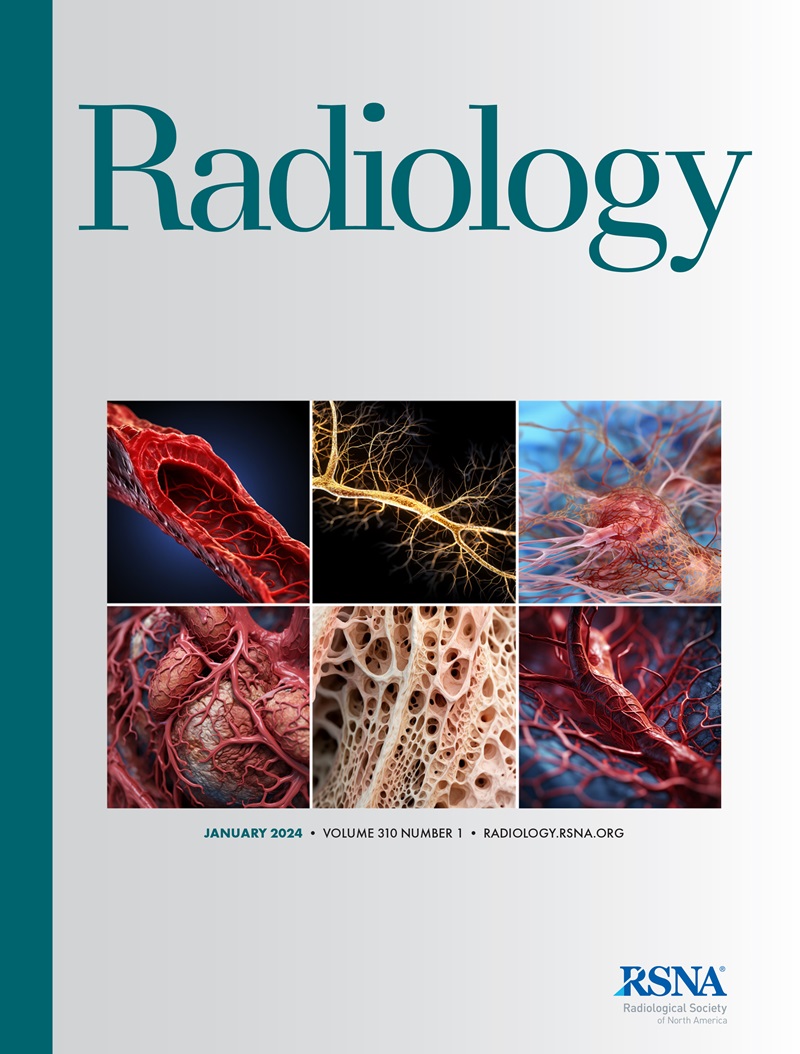Jan Vosshenrich, Mary Bruno, Tatiane Cantarelli Rodrigues, Ricardo Donners, Meghan Jardon, Yannik Leonhardt, Shana G Neumann, Michael Recht, Aline Serfaty, Steven E Stern, Jan Fritz
求助PDF
{"title":"Arthroscopy-validated Diagnostic Performance of 7-Minute Five-Sequence Deep Learning Super-Resolution 3-T Shoulder MRI.","authors":"Jan Vosshenrich, Mary Bruno, Tatiane Cantarelli Rodrigues, Ricardo Donners, Meghan Jardon, Yannik Leonhardt, Shana G Neumann, Michael Recht, Aline Serfaty, Steven E Stern, Jan Fritz","doi":"10.1148/radiol.241351","DOIUrl":null,"url":null,"abstract":"<p><p>Background Deep learning (DL) methods enable faster shoulder MRI than conventional methods, but arthroscopy-validated evidence of good diagnostic performance is scarce. Purpose To validate the clinical efficacy of 7-minute threefold parallel imaging (PIx3)-accelerated DL super-resolution shoulder MRI against arthroscopic findings. Materials and Methods Adults with painful shoulder conditions who underwent PIx3-accelerated DL super-resolution 3-T shoulder MRI and arthroscopy between March and November 2023 were included in this retrospective study. Seven radiologists independently evaluated the MRI scan quality parameters and the presence of artifacts (Likert scale rating ranging from 1 [very bad/severe] to 5 [very good/absent]) as well as the presence of rotator cuff tears, superior and anteroinferior labral tears, biceps tendon tears, cartilage defects, Hill-Sachs lesions, Bankart fractures, and subacromial-subdeltoid bursitis. Interreader agreement based on κ values was evaluated, and diagnostic performance testing was conducted. Results A total of 121 adults (mean age, 55 years ± 14 [SD]; 75 male) who underwent MRI and arthroscopy within a median of 39 days (range, 1-90 days) were evaluated. The overall image quality was good (median rating, 4 [IQR, 4-4]), with high reader agreement (κ ≥ 0.86). Motion artifacts and image noise were minimal (rating of 4 [IQR, 4-4] for each), and reconstruction artifacts were absent (rating of 5 [IQR, 5-5]). Arthroscopy-validated abnormalities were detected with good or better interreader agreement (κ ≥ 0.68). The sensitivity, specificity, accuracy, and area under the receiver operating characteristic curve were 89%, 90%, 89%, and 0.89, respectively, for supraspinatus-infraspinatus tendon tears; 82%, 63%, 68%, and 0.68 for subscapularis tendon tears; 93%, 73%, 86%, and 0.83 for superior labral tears; 100%, 100%, 100%, and 1.00 for anteroinferior labral tears; 68%, 90%, 82%, and 0.80 for biceps tendon tears; 42%, 93%, 81%, and 0.64 for cartilage defects; 93%, 99%, 98%, and 0.94 for Hill-Sachs deformities; 100%, 99%, 99%, and 1.00 for osseous Bankart lesions; and 97%, 63%, 92%, and 0.80 for subacromial-subdeltoid bursitis. Conclusion Seven-minute PIx3-accelerated DL super-resolution 3-T shoulder MRI has good diagnostic performance for diagnosing tendinous, labral, and osteocartilaginous abnormalities. © RSNA, 2025 <i>Supplemental material is available for this article.</i> See also the editorial by Tuite in this issue.</p>","PeriodicalId":20896,"journal":{"name":"Radiology","volume":"314 2","pages":"e241351"},"PeriodicalIF":12.1000,"publicationDate":"2025-02-01","publicationTypes":"Journal Article","fieldsOfStudy":null,"isOpenAccess":false,"openAccessPdf":"","citationCount":"0","resultStr":null,"platform":"Semanticscholar","paperid":null,"PeriodicalName":"Radiology","FirstCategoryId":"3","ListUrlMain":"https://doi.org/10.1148/radiol.241351","RegionNum":1,"RegionCategory":"医学","ArticlePicture":[],"TitleCN":null,"AbstractTextCN":null,"PMCID":null,"EPubDate":"","PubModel":"","JCR":"Q1","JCRName":"RADIOLOGY, NUCLEAR MEDICINE & MEDICAL IMAGING","Score":null,"Total":0}
引用次数: 0
引用
批量引用
Abstract
Background Deep learning (DL) methods enable faster shoulder MRI than conventional methods, but arthroscopy-validated evidence of good diagnostic performance is scarce. Purpose To validate the clinical efficacy of 7-minute threefold parallel imaging (PIx3)-accelerated DL super-resolution shoulder MRI against arthroscopic findings. Materials and Methods Adults with painful shoulder conditions who underwent PIx3-accelerated DL super-resolution 3-T shoulder MRI and arthroscopy between March and November 2023 were included in this retrospective study. Seven radiologists independently evaluated the MRI scan quality parameters and the presence of artifacts (Likert scale rating ranging from 1 [very bad/severe] to 5 [very good/absent]) as well as the presence of rotator cuff tears, superior and anteroinferior labral tears, biceps tendon tears, cartilage defects, Hill-Sachs lesions, Bankart fractures, and subacromial-subdeltoid bursitis. Interreader agreement based on κ values was evaluated, and diagnostic performance testing was conducted. Results A total of 121 adults (mean age, 55 years ± 14 [SD]; 75 male) who underwent MRI and arthroscopy within a median of 39 days (range, 1-90 days) were evaluated. The overall image quality was good (median rating, 4 [IQR, 4-4]), with high reader agreement (κ ≥ 0.86). Motion artifacts and image noise were minimal (rating of 4 [IQR, 4-4] for each), and reconstruction artifacts were absent (rating of 5 [IQR, 5-5]). Arthroscopy-validated abnormalities were detected with good or better interreader agreement (κ ≥ 0.68). The sensitivity, specificity, accuracy, and area under the receiver operating characteristic curve were 89%, 90%, 89%, and 0.89, respectively, for supraspinatus-infraspinatus tendon tears; 82%, 63%, 68%, and 0.68 for subscapularis tendon tears; 93%, 73%, 86%, and 0.83 for superior labral tears; 100%, 100%, 100%, and 1.00 for anteroinferior labral tears; 68%, 90%, 82%, and 0.80 for biceps tendon tears; 42%, 93%, 81%, and 0.64 for cartilage defects; 93%, 99%, 98%, and 0.94 for Hill-Sachs deformities; 100%, 99%, 99%, and 1.00 for osseous Bankart lesions; and 97%, 63%, 92%, and 0.80 for subacromial-subdeltoid bursitis. Conclusion Seven-minute PIx3-accelerated DL super-resolution 3-T shoulder MRI has good diagnostic performance for diagnosing tendinous, labral, and osteocartilaginous abnormalities. © RSNA, 2025 Supplemental material is available for this article. See also the editorial by Tuite in this issue.

 求助内容:
求助内容: 应助结果提醒方式:
应助结果提醒方式:


